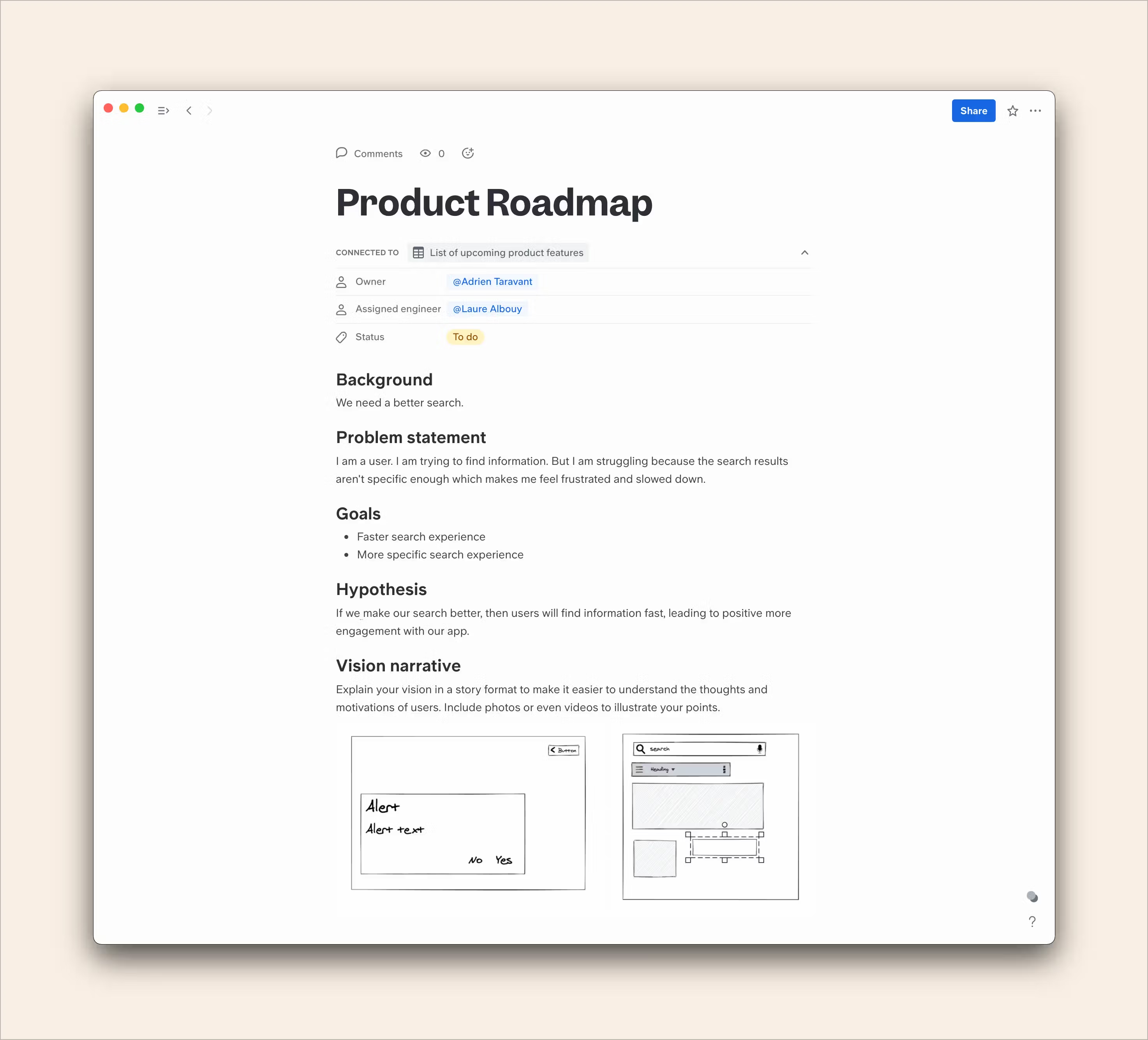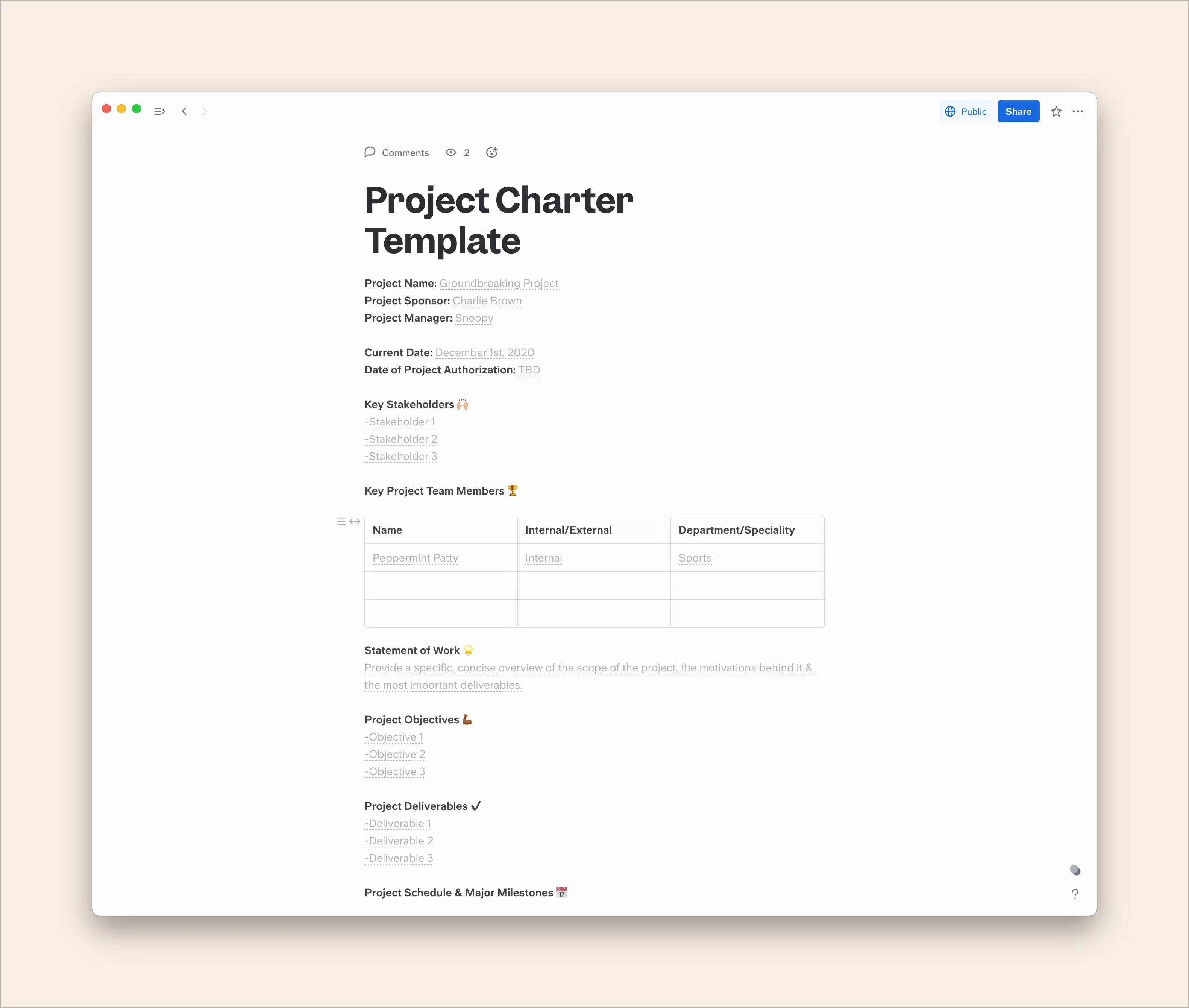What is a Project Charter?
A project charter is a key internal document that describes the scope, participants and goals of a project. It contains a clear list of responsibilities, roles and stakeholders. It's usually developed right at the beginning of a project's lifecycle and is used as a reference point throughout a project's development.
We know, there are so many kinds of project management tools and documents vying for importance. However, if you're going to be deeply familiar with one project planning document, we'd highly recommend the project charter. We'll explain in this guide why we think so.
What does a Project Charter do?
First, they authorize the existence of a given project. This may sound strange, but a project isn't a project unless it's authorized by the powers that be.
Second, they provide an overview of the key elements of a project. You won't find excessive detail in project charters, but they provide concise information about a project's most important aspects. The details get added and expanded upon in more dynamic documents down the road.
Basically, a high-quality project charter document will act as an anchor for your entire project, making it an incredibly important tool.
Now, let's talk a little bit more about what differentiates a project charter from other related documents...
Is a Project Charter that important?
There are so many reasons why project charter documents are important, but the following are absolutely key:
1. The project charter is the document that formally brings a project to life. That might sound dramatic, but it authorizes the project's existence as well as the project team to do what they have to do to make the project successful. This is extremely important when it comes to planning, development, and even potential conflicts later on.
2. Project charters provide essential direction and focus. They also act as foundational documents that get built upon further throughout a project's life cycle. A solid project charter makes an excellent foundation for more dynamic external documents down the road, including project plans, marketing plans, and the like.
When should you develop a Project Charter?
The earlier the better. Seriously, a project shouldn't (and technically can't) be started until there's a good project charter in place. They come at the very beginning of a project's existence, and for a good reason.
Since project charters provide both direction and authorization, they're essential to taking the first steps in any successful project. The clarity they facilitate also fosters shared understanding and reduces the likelihood of misunderstandings and signals getting crossed down the road.

What does a Project Charter document contain?
A great Project Charter Document should contain:
- Basic project information: This introductory section includes the obvious, but it needs to be officially noted down somewhere. Cover elements such as project name, project sponsor, project manager, main stakeholders & project team members.
- General project requirements
- Statement of Work (SOW): As discussed above, the statement of work arguably the most important element of a project charter. It acts as the basis for the charter's development. Think project goals & objectives, general criteria & business case.
- Project activities: This illustrative section includes elements like project schedule & major milestones.
- Initial project budget
- Project constraints, assumptions, risks & dependencies
- Project success criteria
- Project authorization & approval documents: These documents are often included in some form of project charter annex and can apply to initial project approval as well as final project approval depending on the situation.
Our free project charter template
Don't be intimidated by project charters. Developing an excellent, useful project charter document doesn't have to be an impossible task.
If you're feeling overwhelmed getting started, we've got your back. Follow the template below and you can't go wrong. You'll be pleasantly surprised at how easily everything will come together and what a positive effect your finished project charter will have on your project planning and management process.

Essential Project Charter tips
1. Work collaboratively
Project charters are wonderful because they provide clarity regarding project direction. In order to ensure that all key players are on the same page from the get-go and that your project is built on a collaborative foundation, have your team leaders work together on project charter development. You won't be able to include everyone, but make sure to include project managers, stakeholders, project sponsors and any key experts you deem necessary.
2. Stay organized
This tip might seem obvious, but it's overlooked far too often. A project charter document is no good if it isn't well organized. It should be easy to read and find information. Make sure all your project charter elements are laid out clearly, use headers and include a table of contents where appropriate.
3. Be concise & specific
Specifics are what turn an average project charter into an excellent project charter. We've said it once and we'll say it again... project charters should answer questions, not prompt them. Make sure you provide your reader with all the key details they need to know about your project. Don't speak vaguely; provide specific and measurable information.
Example: If one of your project objectives is capitalizing on your company's social media presence, think: 'We will use our social media presence on X platform to do X, Y & Z in order to achieve X.'
This tip provides an added benefit... thinking about specifics often helps flesh out ideas and separate the good ones from the bad ones.
4. Use a high-quality project charter template
We're not going to lie, putting together your first project charter document can be a daunting task. There a lot to keep in mind and not much room for error. If this is your first project charter (or you just want a little extra help), your life will be made a lot easier by using a high-quality project charter template. If you're still feeling lost, you can also research project charter examples for extra inspiration.
5. Be transparent & seek approval along the way
If you're a team leader working on a project charter document, now is the time to voice concerns and ideas about project direction. Don't be shy; being transparent, asking questions and sharing ideas should absolutely be prioritized at this stage. Project charters act as foundations for entire projects and it only gets more complicated to make changes down the road. Make sure all voices are heard as development continues and seek ongoing feedback & approval before putting together the finished product.
Pro Tip 💡: Hold feedback meetings, either in-person or via video conference. Sometimes document edits and emailing back and forth doesn't cut it. Authentic feedback should be discussed face-to-face, even digitally.
Project charters are your friend
As you can see, there's no reason to fear project charter documents. In fact, project charters are your friend. They're concise, help you get organized, provide direction, and get your whole project team on the same page from the get-go.
Trust us, it's absolutely worth it to invest a little bit of time into assembling a killer project charter document at the beginning of your project planning process.You'll have an invaluable resource to refer back to throughout the rest of your project's development.
When you get going developing your own project documentation, make sure to refer back to this resource if you have any questions or require any guidance. We love seeing collaborative projects get completed and become successful!
What's the Difference Between a Project Charter, a Statement of Work (SOW) and a Project Plan?
No matter how familiar you are with the project management body of knowledge (PMBOK), project management institute (PMI) lingo or project management tools in general, these terms can be easily confused. While they're similar, there are some key differences to remember. Let's take a moment to clarify them:
- Project Proposal:
A project proposal comes first. It is intended to persuade the stakeholders by explaining why the project should be carried out. - Project Charter:
A project charter is a document that formalizes a specific project's existence. It authorizes the initiation of a given project, as well as team members to start working on it. Project charter documents are also internal, short documents that are most often seen at the beginning of a project's lifecycle. - Statement of Work (SOW): Project charters and statements of work are like peanut butter and jelly... you can't have one without the other. Statements of work usually come before project charters and act as their foundation. SOWs normally provide an overview of project scope, business needs, deliverables, and measurable project objectives and criteria.
- Project plan: Project plans come in later. Think of a project charter as step one in the project planning process... if all goes well, project charters grow into project plans as their progress in their project schedules and lifecycles. Project plans are more dynamic documents than project charters; they're normally updated frequently and are often used both internally and externally.
Good news, Slite's design helps you build a simple structure to foster thoughtful inputs on projects. Build Slite the way you need it and focus on delivering on your projects, while making sure every info is easy to find.
Who puts together Project Charters?
Project charters are normally assembled by a combination of project managers, project management professionals (PMPs), project team members, key stakeholders and project sponsors. Basically, everyone
Since Project Charters are developed at the very start of the project planning process, whoever acts as the project initiator (usually the person paying for the bulk of the project) calls for their formation. Then, whoever has project manager authority (usually the project manager) becomes responsible for activating the organizational resources at their disposal to put everything together into a formal document.

